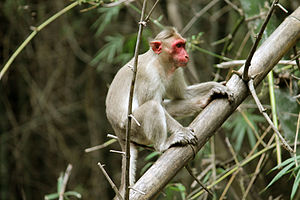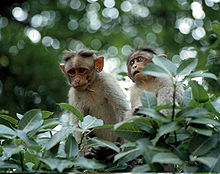Indian hat monkey
| Indian hat monkey | ||||||||||||
|---|---|---|---|---|---|---|---|---|---|---|---|---|

Indian hat monkey |
||||||||||||
| Systematics | ||||||||||||
|
||||||||||||
| Scientific name | ||||||||||||
| Macaca radiata | ||||||||||||
| ( É. Geoffroy , 1812) |
The Indian hat monkey ( Macaca radiata ) is a primate species from the genus of macaques within the family of the vervet monkeys (Cercopithecidae). Like the closely related Ceylon hat monkey, it owes its name to the striking crown of hair on its head.
description
Indian hat monkeys are among the smaller macaques with a weight of 2.5 to 8 kilograms. Their short fur is gray-brown on the top and whitish on the underside. On the top of the head they have two heads of brown or black hair that are directed outwards and parted in the middle. The bare face is colored brown; the tail is as long or longer than the body.
distribution and habitat
Indian hat monkeys live in southern India from southern Maharashtra and Andhra Pradesh to the south. Their habitat are forests and open terrain up to an altitude of 2200 meters.
Way of life
Indian hat monkeys are diurnal. They spend part of the day on the ground but usually return to the trees to sleep. The human closeness doesn't seem to matter to them. They are also found near villages and settlements.
They live in large groups made up of around twice as many females as males. There is a strict hierarchy within the males, which is expressed in the order in which they search for food and in grooming. While females remain in the group in which they were born, males must leave their group after reaching sexual maturity.
Indian hat monkeys feed primarily on fruits, seeds, insects and grasses.
Reproduction
In contrast to other macaque species, there is no normal swelling in hat monkeys. This is the swelling of the bare buttocks area in females during fertile times. After a gestation period of around 150 to 170 days, a young animal is born. The fathers do not take part in raising the young. Weaning occurs after around a year, and the young are sexually mature after 2.5 to 7 years. The life expectancy of hat monkeys in the wild is around 20 years.
Indian hat monkeys and people
The Indian hat monkeys have adapted to humans to a certain extent. They plunder plantations and fields and also live near villages and temples. The main threat is the clearing of forests and the associated loss of habitat. The Indian hat monkey is a widespread, non-threatened species.
literature
- Thomas Geissmann : Comparative Primatology. Springer-Verlag, Berlin et al. 2003, ISBN 3-540-43645-6 .
- Don E. Wilson, DeeAnn M. Reeder (Eds.): Mammal Species of the World. A taxonomic and geographic Reference. Johns Hopkins University Press, Baltimore MD 2005, ISBN 0-8018-8221-4 .
Web links
- Sally Walker and Sanjay Molur: Guide to South Asian Primates for Teachers and Students of All Ages (PDF) (1.99 MB)
- Information on primatis.de
- Macaca radiata in the endangered Red List species the IUCN 2006. Posted by: Eudey et al, 2000. Retrieved on 12 May 2006..
